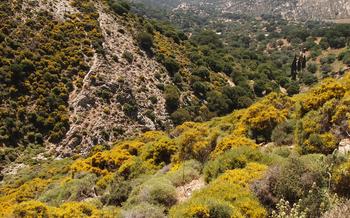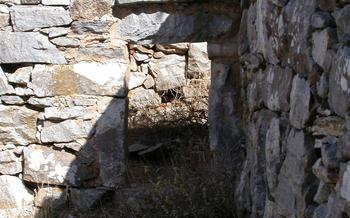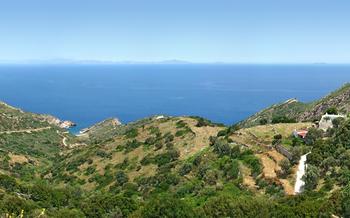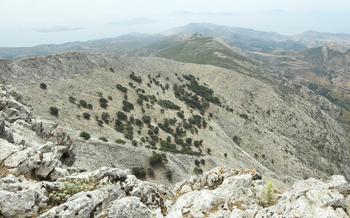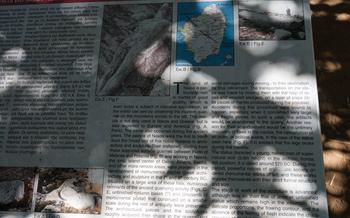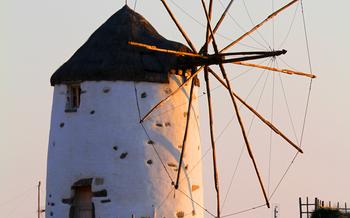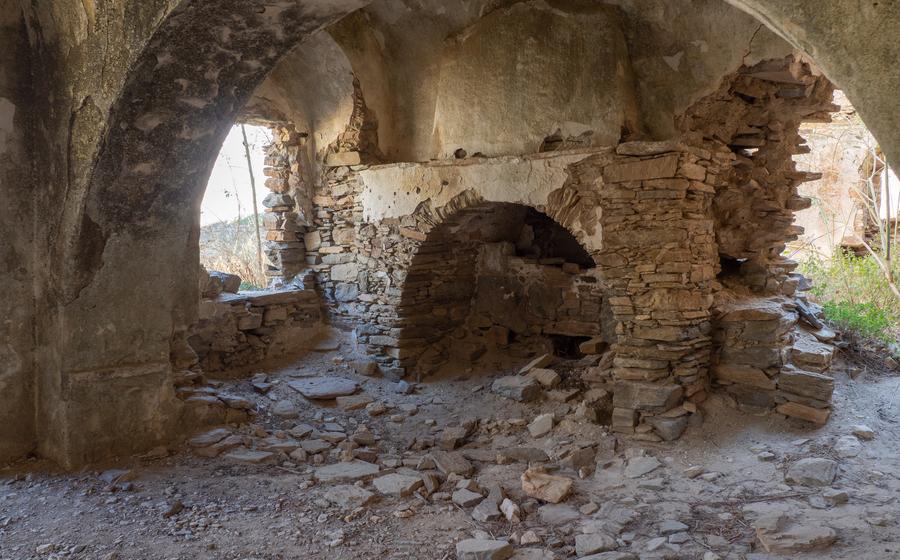
The Jesuit Monastery in Kalamitsia
- The Monastery in Kalamitsia Naxos
- Historical Overview
- Architectural Features
- The Church of the Transfiguration
- The Monastery's Courtyard: A Haven of Serenity
- Exploring the Ruins
- The Legendary Tunnel
- Visiting the Monastery
- Transportation to Kalamitsia
- Accommodation Options
- Local Cuisine
- Combining History and Nature:
- Photography Tips
- Off-Season Charm:
- Insider Tip: Uncovering Hidden Gems
The Monastery in Kalamitsia Naxos
Nestled amidst the rolling hills of Naxos, the Jesuit Monastery in Kalamitsia stands as a testament to the island's rich history and cultural heritage. Built in the 17th century, the monastery played a significant role during the Venetian and Ottoman periods, serving as a spiritual and educational center for the local community. Its impressive architecture, well-preserved frescoes, and peaceful atmosphere make it a must-visit destination for history buffs, architecture enthusiasts, and travelers seeking tranquility.
History
The Jesuit Monastery in Kalamitsia was founded in 1627 by the Jesuit Order, a Catholic religious order known for its missionary work and educational institutions. During the Venetian rule of Naxos, the monastery flourished as a center of learning and spirituality, attracting students from across the island. It remained under Jesuit control until the Ottoman conquest of Naxos in 1670, when it was converted into a mosque. Following Greece's independence in the 19th century, the monastery was abandoned and fell into disrepair.
Architecture
The Jesuit Monastery in Kalamitsia is a remarkable example of Baroque architecture, characterized by its intricate detailing and dramatic use of light and shadow. Constructed from local stone, the monastery features thick walls, arched doorways, and a towering bell tower that dominates the surrounding landscape. The interior of the monastery is equally impressive, with a spacious courtyard surrounded by elegant arcades and a beautifully decorated church.
Cultural Significance
The Jesuit Monastery in Kalamitsia holds significant cultural importance as a symbol of Naxos's rich history and diverse religious heritage. It represents the island's connection to the Catholic Church during the Venetian period and serves as a reminder of the Ottoman occupation. The monastery's well-preserved architecture and frescoes provide a glimpse into the artistic and cultural achievements of Naxos during this time.
Historical Overview
The Jesuit Monastery in Kalamitsia, Naxos, boasts a rich and intriguing history, deeply intertwined with the island's cultural and religious heritage. Its story begins in the 16th century when the Jesuit Order, a prominent Catholic religious organization, arrived on Naxos under Venetian rule. The Jesuits played a pivotal role in spreading Catholicism on the island, establishing schools, churches, and monasteries, including the one in Kalamitsia.
During the Venetian era, Naxos experienced a period of prosperity and cultural flourishing. The monastery served as a vital center for education and religious worship, contributing to the island's vibrant intellectual and spiritual landscape. However, the Ottoman occupation of Naxos in the 17th century brought significant changes. The monastery faced challenges and restrictions under Ottoman rule, but it managed to endure as a testament to the resilience of the Catholic faith on the island.
Throughout its history, the monastery has undergone various renovations and additions, reflecting the changing needs and influences of different periods. Today, it stands as a remarkable fusion of architectural styles, embodying the diverse cultural heritage of Naxos.
Architectural Features
The Jesuit Monastery in Kalamitsia, Naxos stands out for its unique architectural design, blending Baroque elements with traditional Cycladic influences. Its thick stone walls, weathered by time, exude a sense of history and resilience. The monastery's towering bell tower, a prominent landmark in the area, offers panoramic views of the surrounding countryside, inviting visitors to explore the beauty of Naxos from a different perspective.
The church, dedicated to the Transfiguration of Christ, showcases exquisite interior decor, featuring intricate frescoes and a finely carved iconostasis. The harmonious blend of architectural styles creates a captivating ambiance, transporting visitors to a bygone era of religious devotion and artistic expression.
The Church of the Transfiguration
The Monastery of the Jesuits in Kalamitsia boasts a stunning church dedicated to the Transfiguration of the Savior. Step inside, and you'll be captivated by the intricate interior decor, adorned with vibrant frescoes that depict biblical scenes and the lives of saints. The iconostasis, a magnificent screen separating the sanctuary from the nave, is a true masterpiece, showcasing the artistic prowess of its creators. Each icon is a work of art, telling stories of faith, devotion, and the divine. The church exudes a sense of spirituality and serenity, inviting visitors to immerse themselves in its religious significance and marvel at the beauty that surrounds them.
The Monastery's Courtyard: A Haven of Serenity
Amidst the monastery's imposing architecture and rich history lies a tranquil oasis—the courtyard. Step inside to be greeted by the soft rustling of leaves and the gentle murmur of water. Well-preserved gardens, bursting with colorful blooms and fragrant herbs, line the perimeter, creating a vibrant tapestry of nature. At its heart, an ancient cistern stands as a testament to the monastery's self-sufficiency, its weathered stone walls whispering tales of a bygone era. As you wander through this serene space, take a moment to appreciate the stunning views that unfold before you. The courtyard offers panoramic vistas of the surrounding countryside, with rolling hills, olive groves, and the sparkling Aegean Sea painting a breathtaking backdrop. The monastery's courtyard is not just a physical space but a sanctuary for the soul, inviting visitors to find solace, tranquility, and a deep connection with the natural world.
Exploring the Ruins
Strolling through the monastery grounds, visitors will encounter remnants of the past in the form of abandoned buildings and crumbling walls. These ruins, although weathered by time, exude a unique historical charm that transports visitors back to a bygone era. The monastery's storied past is palpable as one explores these remnants, each whispering tales of its former glory and the lives that once thrived within its walls.
For photography enthusiasts, the ruins present an array of captivating subjects. The play of light and shadow on the aged stone walls, the intricate details of crumbling arches, and the contrast between the ancient structures and the surrounding greenery create a visual feast. Exploring these ruins offers an opportunity to capture stunning photographs that evoke a sense of history and intrigue.
The Legendary Tunnel
The Jesuit Monastery in Kalamitsia is shrouded in intrigue and local folklore, with one of the most captivating tales being the legendary tunnel. According to local lore, the monastery once housed a secret passage, a hidden tunnel that led to the nearby village of Koronos. This tunnel is said to have served as a clandestine escape route for monks and other inhabitants during times of danger or persecution.
The existence of this tunnel has been debated for centuries, with some dismissing it as mere myth and others claiming to have stumbled upon its entrance. While there is no definitive evidence to confirm or deny the existence of this subterranean passageway, its enduring presence in local folklore adds an air of mystery and intrigue to the monastery's history.
Whether or not the tunnel truly exists, exploring the legend itself offers a fascinating glimpse into the monastery's rich heritage and the colorful stories that have been woven around it over the centuries. Embracing the mystique of the legendary tunnel enhances the overall experience of visiting the Jesuit Monastery in Kalamitsia, inviting visitors to delve into the realm of imagination and wonder.
Visiting the Monastery
Visiting the Jesuit Monastery in Kalamitsia, Naxos, is a unique and enriching experience that allows you to delve into the island's rich history and cultural heritage. The monastery is open to the public, and visitors are welcome to explore its various sections, including the church, the courtyard, and the ruins.
Opening Hours
The monastery's opening hours vary depending on the season. During the summer months, it is typically open from 9:00 AM to 7:00 PM, while in the winter months, it may have reduced hours or be closed altogether. It is advisable to check with the local tourist office or a reliable online source for the most up-to-date information.
Admission Fees
Admission to the monastery is free of charge, making it an accessible attraction for travelers of all backgrounds. This allows visitors to explore the monastery's many features without any financial barriers, encouraging a deeper appreciation for its historical and cultural significance.
Guided Tours
For those seeking a more in-depth understanding of the monastery's history and architecture, guided tours are available. These tours are typically conducted by knowledgeable local guides who can provide insights and anecdotes that enhance the visitor experience. Guided tours may be offered on a regular schedule or can be arranged in advance for groups or individuals.
Self-Guided Exploration
Visitors who prefer to explore the monastery at their own pace can opt for self-guided exploration. The monastery's well-preserved grounds and informative signage allow visitors to navigate independently and discover the site's many highlights. This option offers flexibility and the freedom to linger in areas of particular interest, creating a more personalized experience.
Transportation to Kalamitsia
Reaching Kalamitsia is a breeze, with various transportation options to suit your needs. Embrace the scenic journey as you explore the island's captivating landscapes.
- Bus Routes:
- Naxos Town serves as the central transportation hub.
- Regular bus routes connect Naxos Town to Kalamitsia, offering a budget-friendly option.
-
Check bus schedules to plan your trip accordingly.
-
Taxi Services:
- Convenient and comfortable, taxis are readily available in Naxos Town.
- Pre-book a taxi to ensure a smooth journey to Kalamitsia.
-
Taxis offer flexibility and can accommodate larger groups.
-
Rental Car Options:
- Experience the freedom of exploring Naxos at your own pace with a rental car.
- Several car rental agencies operate on the island.
-
Book your vehicle in advance to secure the best rates.
-
Driving Directions:
- From Naxos Town, follow the signs towards Kalamitsia.
- The drive takes approximately 30 minutes, offering panoramic views along the way.
- Enjoy the scenic journey as you immerse yourself in the island's natural beauty.
Accommodation Options
When planning your stay in Naxos, you'll find a range of accommodation options to suit various preferences and budgets. Whether you seek the comfort of a modern hotel, the charm of a traditional guest house, or the independence of an Airbnb rental, you'll have plenty of choices.
- Nearby Hotels:
-
For a convenient and luxurious stay, consider booking a room at one of the nearby hotels, offering amenities like swimming pools, restaurants, and breathtaking sea views.
-
Traditional Guest Houses:
-
Immerse yourself in the island's culture by opting for a traditional Naxian guest house. These charming accommodations often feature whitewashed walls, colorful shutters, and balconies overlooking the picturesque surroundings.
-
Airbnb Rentals:
-
For a more personalized and local experience, consider renting an Airbnb property. You'll find a variety of apartments, houses, and villas available, allowing you to enjoy the comforts of home while exploring the island.
-
Planning Your Stay:
- To ensure a hassle-free trip, book your accommodation in advance, especially during the peak season. Consider factors like location, amenities, and budget when making your choice.
Local Cuisine
Naxos is a culinary paradise, boasting a rich gastronomic tradition influenced by its Venetian and Ottoman past. When visiting the Jesuit Monastery in Kalamitsia, immerse yourself in the local flavors by savoring Naxian specialties. Fresh seafood is a must-try, with dishes like grilled octopus, succulent lobster, and aromatic fish stews delighting your palate. Don't miss the opportunity to visit local wineries, where you can sample the island's renowned wines, such as the crisp white Kitron and the robust red Mandilaria. Engage in culinary experiences, taking cooking classes to learn the art of Naxian cuisine or embarking on a gastronomic tour to discover hidden gems and local delicacies. Indulge in the island's culinary delights while exploring the historical and natural wonders of Naxos.
Combining History and Nature:
The Monastery of Kalamitsia is not just a historical site but also a gateway to the natural wonders of Naxos. Its surroundings boast scenic hiking trails that wind through ancient olive groves, offering breathtaking views of the Aegean Sea and the surrounding landscape. Visitors can embark on a leisurely hike, immersing themselves in the island's natural beauty while tracing the footsteps of history. The well-preserved olive trees, some centuries old, add a touch of antiquity to the experience, providing a glimpse into Naxos' rich agricultural heritage. Exploring the surroundings of the monastery allows visitors to combine their fascination with history and their appreciation for the natural world, creating a truly memorable experience.
Photography Tips
To truly capture the beauty of the Jesuit Monastery in Kalamitsia and its surroundings, consider these photography tips:
-
Golden Hour Magic: Time your visit for the golden hours, just after sunrise or before sunset, when the warm light casts a magical glow on the monastery's stone walls.
-
Play with Shadows: Take advantage of the monastery's unique architecture to create interesting shadows that add depth and drama to your shots.
-
Compose Your Frame: Experiment with different angles and compositions to find unique perspectives that showcase the monastery's grandeur.
-
Include the Landscape: Step back and capture the monastery within its natural setting, surrounded by the rolling hills and the Aegean Sea.
-
Capture the Details: Don't forget to zoom in on intricate details like the carvings on the bell tower or the frescoes in the Church of the Transfiguration.
-
Go Beyond the Monastery: Explore the surrounding area for additional photo opportunities, such as the picturesque village of Kalamitsia or the nearby beaches.
-
Embrace the Off-Season: If possible, visit during the off-season when the monastery is less crowded, allowing you to capture serene and atmospheric shots without distractions.
-
Share Your Masterpieces: Don't forget to share your stunning photographs with the world on social media, using relevant hashtags like #JesuitMonastery, #Naxos, and #Greece.
Off-Season Charm:
Venturing to the Jesuit Monastery in Kalamitsia during the off-season months offers a unique and tranquil experience. The absence of large tourist crowds allows visitors to immerse themselves in the monastery's history and ambiance without distractions. This serene atmosphere provides ample opportunities for quiet contemplation, peaceful exploration, and a deeper connection with the site's spiritual significance.
Moreover, the off-season presents an occasion to engage in authentic cultural interactions with local residents, who are often more available and eager to share their insights and stories about the monastery and the surrounding area. By avoiding the peak tourist season, visitors can discover the monastery's hidden corners, enjoy the serene landscapes, and create lasting memories in a truly unique and authentic setting.
Insider Tip: Uncovering Hidden Gems
While exploring the monastery, keep an eye out for hidden gems that often go unnoticed. Venture beyond the main courtyard to discover secluded corners, charming nooks, and picturesque views. Engage with the locals, who are always eager to share their knowledge and recommendations. They might point you towards a secret garden, a hidden chapel, or a lesser-known viewpoint that offers a breathtaking panorama of the surrounding landscape. Embracing these insider tips will enhance your visit, allowing you to experience the monastery's magic in a deeper and more meaningful way.

